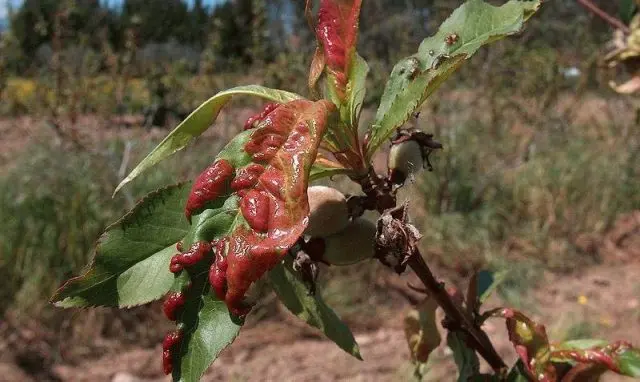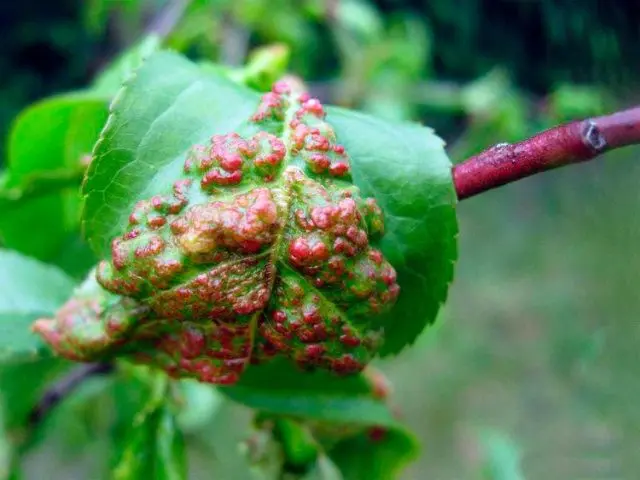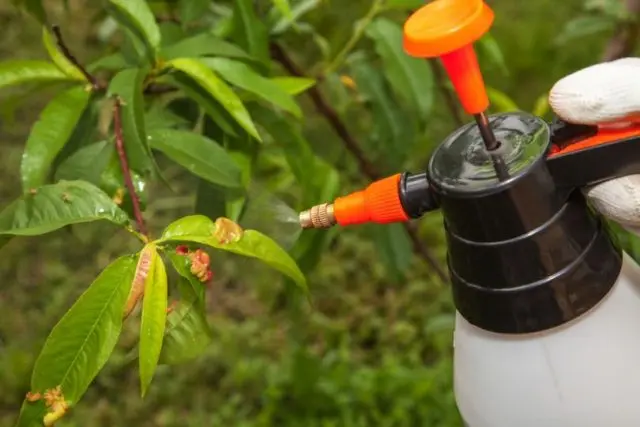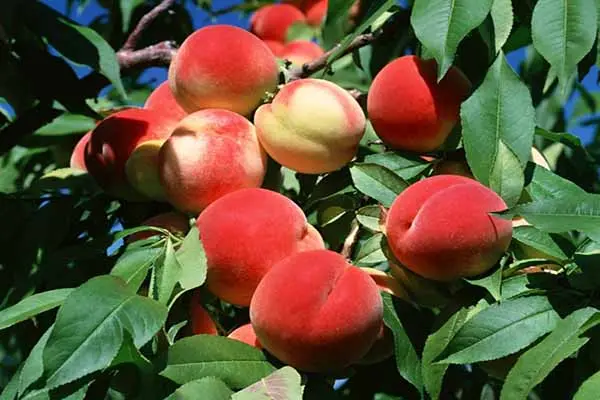Contents
Peach leaf curl is one of the most dangerous diseases that causes the greatest harm. Measures aimed at saving the affected tree must be taken urgently, otherwise you can be left without a crop or lose most of it. Every gardener should understand that leaf curl is not only an aesthetic defect. This disease can sometimes even lead to the complete death of the tree.

What is peach leaf curl disease?
The ringworm (Taphrinadeformans) is a provocateur of the development of peach leaf curl, the spores of which penetrate into wounds and cracks in the bark, under the scales of flower and leaf buds. The activation of the vital activity of fungal spores leads to the formation of a fungus. The first signs of the disease appear in early spring, during bud break. It usually develops in conditions of high humidity and low ambient temperature. The most favorable period for the development of the disease is a cool temperature (6-8 ° C) and a long spring.
Treatment of a disease such as peach leaf curl is best started in the early stages, when the first signs appear. Otherwise, infection of leaf buds will occur, and the disease will begin to actively develop. First, a kind of light green bubbles appear on young blossoming leaves. After that, peach leaves fade, then turn red and curl. Affected foliage becomes deformed and thickened, becomes brittle and eventually dries out.
7-14 days after the onset of the disease, marsupial spores of the fungus begin to develop on both sides of the leaves. Their formation is manifested in the form of a wax coating, gray or white. The period of spraying spores of the peach leaf curl pathogen falls on the last month of spring, the second or third decade. At this time, the defeat of the shoots occurs. Their growth is inhibited, they begin to turn yellow, and by the end of July they completely die.
What is dangerous disease
Sometimes the curly peach leaves go into a chronic stage, which is characterized by a delay in the growth of trees in the spring and an increase in the period of their susceptibility to infection. The disease in the advanced stage leads to the complete exposure of the trunks of peaches, the defeat of young shoots and ovaries. The remaining fruits do not develop fully, harden, losing their taste. Affected trees lag behind in growth, their winter hardiness decreases. The lack of timely assistance most often leads to the complete death of peaches, within 2-3 years after infection.
How to deal with peach curl
Almost every gardener who has planted a peach in his garden faces such a problem as leaf curling for 2-3 years. And immediately questions arise, how to treat peach diseases and how to get rid of peach leaf curl.
It is quite difficult to deal with peach curl during the progression of the disease. Most often, experienced gardeners first apply mechanical methods, and then they proceed to chemical treatments.

If the peach leaves are twisting, you can use the following methods of struggle:
- Removal and destruction of infected foliage.
- Treatment of the garden with chemicals (insecticides and fungicides).
- The use of folk remedies.
- Preventive measures.
Removal and destruction of damaged foliage
Mechanical methods of struggle include the removal and destruction (burning) of damaged leaves and shoots. Pruning peach leaves that are spinning can be done in several stages:
- in spring before buds swell or in autumn;
- during the growing season, immediately after flowering;
- repeated removal of the affected shoots until the dispersal of pathogenic spores.
Pruning affected leaves and shoots is considered the most effective way to combat curl. It is best to carry out this procedure in May, when signs of leaf curl are most noticeable. At the same time, during this period, there will be no active spread of fungal spores.
How to treat peach from leaf curl
Many gardeners are interested in the question of how the garden can be treated if leaves are curled on a peach. The best results are obtained by the treatment of horticultural crops with chemicals. When choosing a remedy, one should focus on the period when the infection occurred, as well as when the first signs of the disease were detected.
- Spraying trees with a solution of 3% Bordeaux mixture. Carried out in the phase of raspberry buds.
- Treatment of peaches immediately after flowering with fungicides in combination with insecticides. If necessary, after 10-12 days, the treatment with fungicides can be repeated.
- Spraying the leaves during the period of active leaf fall with a 1% solution of copper sulfate. You can use Bordeaux mixture if such treatment was not carried out in early spring.
Very often, a Bordeaux mixture is used to treat peach from curlyness, which copes well with the disease. But this method has one significant drawback – this drug is very phytotoxic. The use of the product can lead to a delay in fruiting. As a result, yields may decrease.
Also, when peach is treated with Bordeaux liquid, the content of copper in the foliage increases, and with the growth of shoots, the amount of heavy metal increases even more. Despite the shortcomings, the drug is considered quite effective and its use is fully justified in cases where peach curl has been observed for several seasons.
If the degree of damage is high enough, then it is recommended to use systemic drugs for treatment, such as:
- “Horus”;
- “Delan”;
- “Score”.
They can be used both individually and in complex treatment. Processing should be repeated periodically. Multiplicity of carrying out – 1 time in 10-14 days. According to experts, the effectiveness of these drugs is 98%.

You can also treat with biological products, for example, these:
- Phytosporin;
- Pentaphage;
- Trichodermin;
- Planriz;
- Guapsin.
They are non-toxic, so they can be used throughout the growing season, but basically they will not be able to completely get rid of the fungus with their help.
Recommended treatments for frizziness:
number | Until the dissolution of the kidneys | Immediately after the end of the flowering period | In 10-14 days after flowering | After leaf fall |
1 | A mixture of biological products: “Planriz” (50g / 10 l of water); · “Pentafag” (100 g/10 l of water); “Trichodermin” (100 g / 10 l of water) | A mixture of biological products: Planriz (50 g / 10 l of water); Gaupsin (100 g / 10 l of water); · “Trichodermin” (100 g/10 l of water). | Copper sulfate (1% solution) | |
+ fungicide “Horus” (1/2 norm) | + fungicide “Skor” (½normy) | |||
2 | “Horus” (2 g / 10 l of water) | “Skor” (2 g / 10 l of water)
| Lime milk (2% solution) | |
3 | Copper sulfate (1% solution) | Copper chloride (0,4% solution) | Bordeaux liquid (3% solution) | |
4 | Bordeaux liquid (1% solution) | Polykhom | Urea (6-7% solution) | |
Folk measures to combat peach curl
Clay has been proven by many years of experience as a folk remedy used to combat peach leaf curl. Traditionally, this natural material is used in combination with lime, which acts as an adhesive. In addition to the antifungal effect, clay serves as a kind of adsorbent. It also nourishes the plant, enriching it with a variety of nutrients that help fight leaf curl. Such as:
- sulfur;
- silicon;
- aluminum, etc.
Treatment with clay and lime helps to improve the physicochemical and biological properties of peach, has a phytocidal and fungicidal effect. Prepare a solution in this ratio – 4 parts of clay and 1 part of lime. It is necessary to spray the trees immediately after preparation, until a precipitate has formed in the mixture.
Gardeners also use tobacco infusion to combat peach leaf curl. To prepare a treatment solution, you need 1 kg of raw materials, which must be dissolved in 5 liters of water. The mixture is infused for about 3 days, after which it is diluted with water in a ratio of 1: 2. The prepared solution is sprayed on trees infected with leaf curl. After 7 days, the procedure is repeated.
A set of preventive measures
Preventive measures to combat peach leaf curl begin to be carried out in the fall. When the ambient temperature drops to 10-15 °C. The preventive complex includes the following procedures:
- pruning of affected trees with their subsequent treatment with copper sulphate or sulfur-lime mortar;
- collection of leaves after they fall, followed by composting or burning, as spores of pathogens remain on them;
- tillage with the incorporation of fallen leaves, around the trunks of affected trees, as well as in the aisles of the garden.

In the first decade of March, trees should be sprayed with a solution of copper sulfate (1%) or Bordeaux liquid (3%). After a few days, the treatment is recommended to be repeated. In order to prevent the development of curl in peaches, it is necessary to plant young trees on the sunny side of the garden, in dry areas. You should also pay attention to the variety of peach, choosing for cultivation varieties that are most resistant to curl.
The peach varieties most susceptible to the development of the disease are Armgold, Cornet, Early Cornet, Stark Delicious, Dixired and Collins. Other species have some degree of resistance to the occurrence of this disease.
Conclusion
Peach leaf curl is a disease that cannot be ignored. Treatment should begin as soon as the first signs of infection are found on the trees. Processing fruit trees from diseases is a mandatory procedure for maintaining a garden. By following these simple recommendations, you can easily get rid of such an unpleasant disease as leaf curl and enjoy a rich harvest of peaches.









